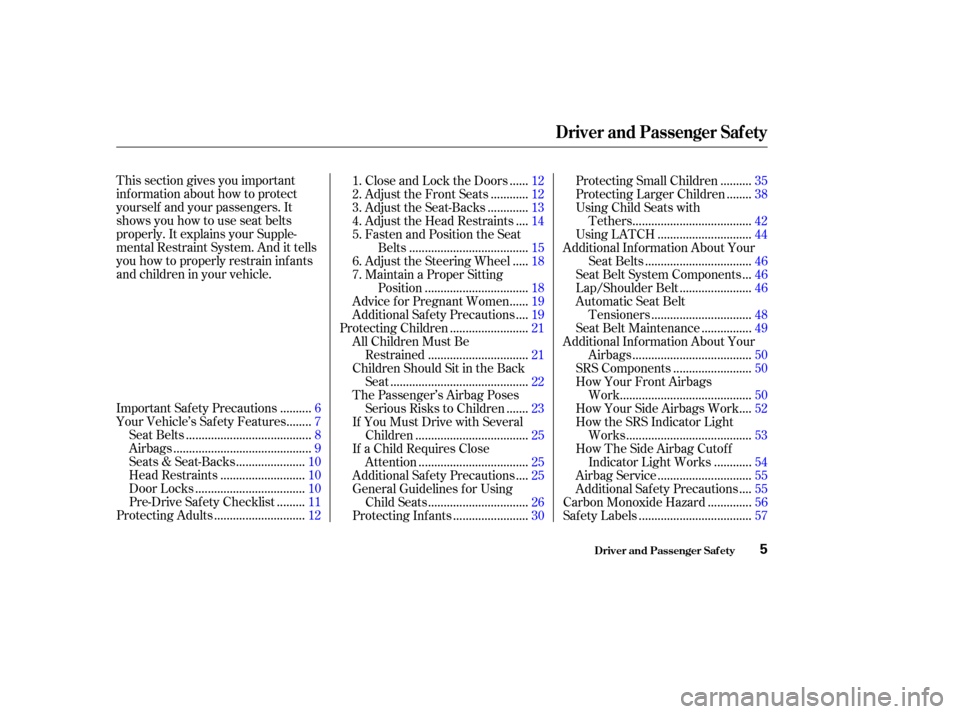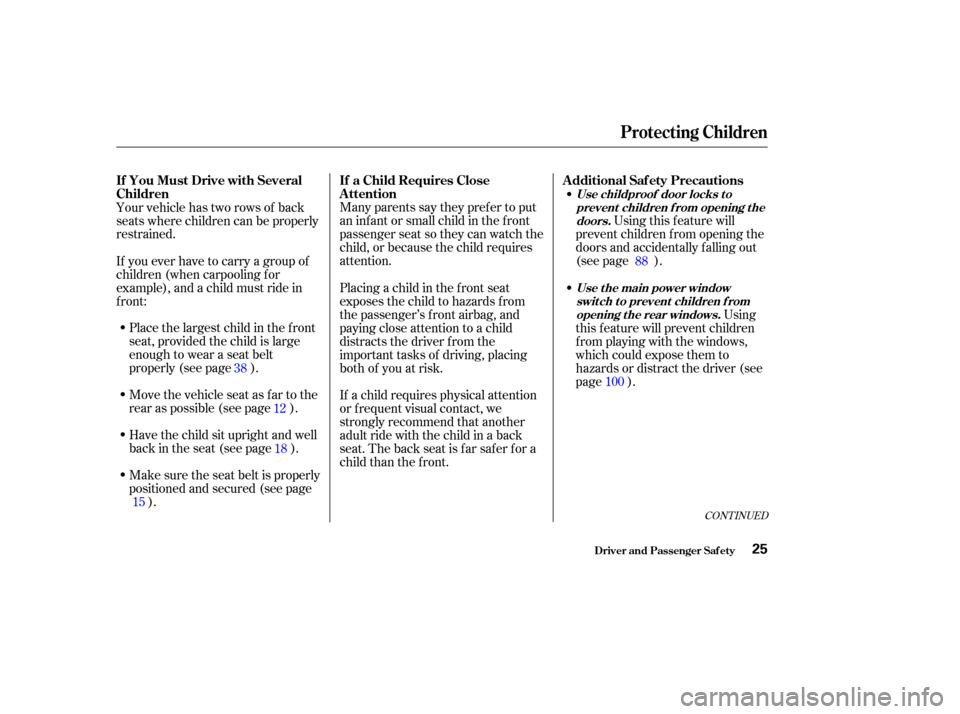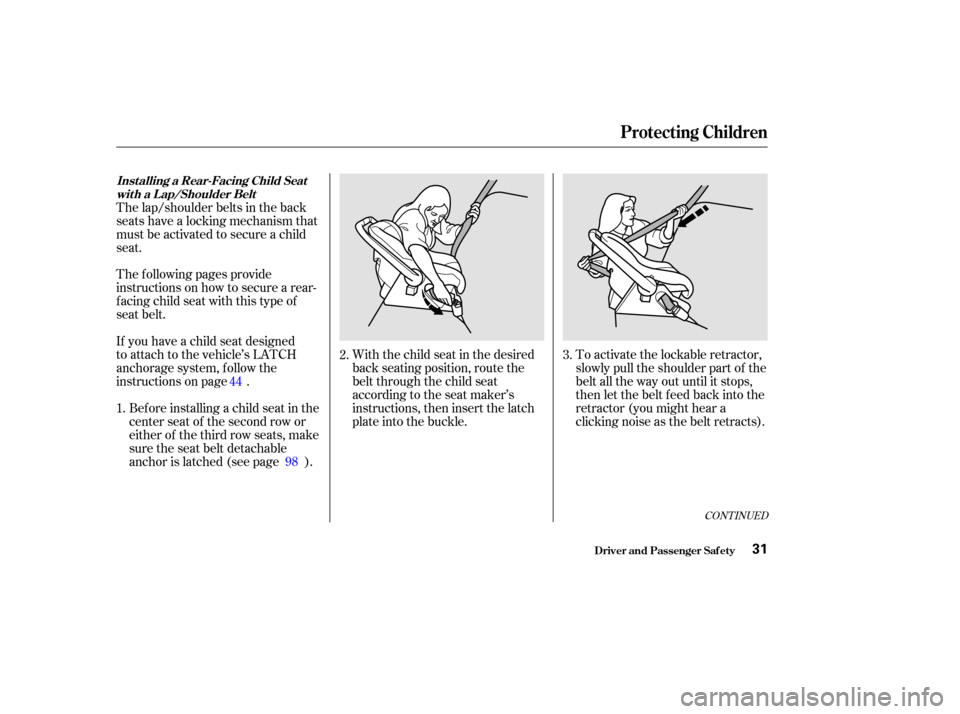lock Acura MDX 2002 Owner's Manual
[x] Cancel search | Manufacturer: ACURA, Model Year: 2002, Model line: MDX, Model: Acura MDX 2002Pages: 372, PDF Size: 5.48 MB
Page 9 of 372

This section gives you important
inf ormation about how to protect
yourself and your passengers. It
shows you how to use seat belts
properly. It explains your Supple-
mental Restraint System. And it tells
you how to properly restrain inf ants
and children in your vehicle..........
Important Safety Precautions .6
.......
Your Vehicle’s Saf ety Features .7
.......................................
Seat Belts .8
...........................................
Airbags .9
.....................
Seats & Seat-Backs .10
..........................
Head Restraints .10
..................................
Door Locks .10
........
Pre-Drive Saf ety Checklist .11
............................
Protecting Adults .12 .....
1. Close and Lock the Doors .12
...........
2. Adjust the Front Seats .12
............
3. Adjust the Seat-Backs .13
...
4. Adjust the Head Restraints .14
5. Fasten and Position the Seat
.....................................
Belts .15
....
6. Adjust the Steering Wheel .18
7. Maintain a Proper Sitting
................................
Position .18
.....
Advice f or Pregnant Women .19
...
Additional Safety Precautions .19
........................
Protecting Children .21
All Children Must Be ...............................
Restrained .21
Children Should Sit in the Back ...........................................
Seat .22
The Passenger’s Airbag Poses ......
Serious Risks to Children .23
If You Must Drive with Several ...................................
Children .25
If a Child Requires Close ..................................
Attention .25
...
Additional Safety Precautions .25
General Guidelines f or Using
...............................
Child Seats .26
.......................
Protecting Inf ants .30 .........
Protecting Small Children .35
.......
Protecting Larger Children .38
Using Child Seats with
.....................................
Tethers .42
.............................
Using LATCH .44
Additional Inf ormation About Your .................................
Seat Belts .46
..
Seat Belt System Components .46
......................
Lap/Shoulder Belt .46
Automatic Seat Belt
...............................
Tensioners .48
...............
Seat Belt Maintenance .49
Additional Inf ormation About Your .....................................
Airbags .50
........................
SRS Components .50
How Your Front Airbags
.........................................
Work .50
...
How Your Side Airbags Work .52
How the SRS Indicator Light
.......................................
Works .53
How The Side Airbag Cutof f ...........
Indicator Light Works .54
.............................
Airbag Service .55
...
Additional Safety Precautions .55
.............
Carbon Monoxide Hazard .56
...................................
Saf ety Labels .57
Driver and Passenger Saf ety
Driver and Passenger Saf ety5
01/09/07 11:56:19 31S3V610_010
Page 14 of 372

Head restraints can help protect you
f rom whiplash and other injuries. For
maximum protection, the back of
your head should rest against the
center of the head restraint.
Reclining a seat-back too f ar reduces
the seat belt’s ef f ectiveness and
increases the chance that the seat’s
occupant will slide under the seat
belt in a crash and be seriously
injured. Move the f ront
seats as far back as possible, and
keep adjustable seat-backs in an
upright position whenever the
vehicle is moving.
Your vehicle’s seats are designed to
keep you in a comf ortable, upright
position so you can take f ull
advantage of the protection offered
by seat belts and the energy
absorbing materials in the seats.
How you adjust your seats and seat-
backs can also affect your safety. For
example, sitting too close to the
steering wheel or dashboard
increases the risk of you or your
passenger being injured by striking
theinsideof thevehicle,orbyan
inf lating airbag. Keeping your doors locked reduces
thechanceof beingthrownoutof
the vehicle during a crash. It also
helps prevent occupants f rom
accidentally opening a door and
f alling out, and outsiders f rom
unexpectedly opening your doors.
Driver and Passenger Saf ety
Seats & Seat-Backs
Head RestraintsDoor L ocks
Your Vehicle’s Saf ety Features
What you should do:
10
01/09/07 11:57:15 31S3V610_015
Page 15 of 372

To make sure you and your
passengers get the maximum
protection f rom your vehicle’s saf ety
f eatures, check the f ollowing each
time before you drive away:All adults, and children who have
outgrown child saf ety seats, are
wearing their seat belts and
wearingthemproperly(seepage ).
Any inf ant or small child is
properly restrained in a child seat
in a back seat (see page ).
Frontseatoccupantsaresitting
upright and as f ar back as possible
f rom the steering wheel and
dashboard (see page ).
Seat-backs are upright (see page ). Head restraints are properly
adjusted (see page ).
Alldoorsandthetailgateare
closed and locked (see page ).
The rest of this section gives more
detailed inf ormation about how you
can maximize your saf ety.
Remember, however, that no saf ety
system can prevent all injuries or
deaths that can occur in severe
crashes, even when seat belts are
properly worn and the airbags deploy. All cargo is properly stored or
secured (see page ).
15 22
12
13 14
12
203
Driver and Passenger Saf ety
Your Vehicle’s Saf ety Features
Pre-Drive Saf ety Checklist
11
01/09/07 11:57:26 31S3V610_016
Page 16 of 372

The f ollowing pages provide
instructions on how to properly
protect the driver and other adult
occupants.
These instructions also apply to
children who have outgrown child
seats and are large enough to wear
lap/shoulder belts. (See page f or
important additional guidelines on
how to properly protect larger
children.)Your vehicle has a door and tailgate
monitor light on the instrument
panel to indicate when a specif ic
door or the tailgate is not tightly
closed.
For security, locked doors can
prevent an outsider f rom
unexpectedly opening a door when
you come to a stop.
See page f or how to lock the
doors. For saf ety, locking the doors reduces
the chance that a passenger,
especially a child, will open a door
while the vehicle is moving and
accidentally f all out. It also reduces
the chance of someone being thrown
out of the vehicle during a crash.
Af ter everyone has entered the
vehicle, be sure the doors and
tailgate are closed and locked. Any driver who sits too close to the
steering wheel is at risk of being
seriously injured or killed by striking
the steering wheel or f rom being
struck by an inflating front airbag
during a crash.
38
82
Driver and Passenger Saf ety
Protecting Adults
Introduction A djust the Front Seats
Close and L ock the Doors
1. 2.
12
01/09/07 11:57:39 31S3V610_017
Page 17 of 372

CONT INUED
To reduce the chance of injury, wear
your seat belt properly, sit upright
with your back against the seat, and
movetheseatawayfromthe
steering wheel to the f arthest
distance that allows you to maintain
f ull control of the vehicle. Also make
sure your f ront seat passenger
moves the seat as far to the rear as
possible.See page f or how to adjust the
f ront seats. Once your seat is adjusted correctly,
rock it back and f orth to make sure
the seat is locked in position. Most shorter drivers can get f ar
enough away f rom the steering
wheel and still reach the pedals.
However, if you are concerned about
sitting too close, we recommend that
you investigate whether some type
of adaptive equipment may help.
The National Highway Traffic Safety
Administration and Transport
Canada recommend that drivers
adjust the seat so the center of the
chest is at least 10 inches (25 cm)
away f rom the center of the steering
wheel.Alsomakesureyourfront
seat passenger moves the seat as f ar
to the rear as possible.
Adjust the driver’s seat-back to a
comf ortable, upright position,
leaving ample space between your
chest and the airbag cover in the
center of the steering wheel. If you
sit too close to the steering wheel,
you could be injured if the f ront
airbag inflates.
90
Driver and Passenger Saf ety
Protecting Adults
Adjust the Seat-Backs
3.
13
Sitting too close to a front
airbag can result in serious
injury or death if the front
airbags inflate.
Always sit as far back from the
front airbags as possible.
01/09/07 11:57:50 31S3V610_018
Page 23 of 372

Pregnant women should also sit
upright and as f ar back as possible
f rom the steering wheel or
dashboard. This will reduce the risk
of injuries to both the mother and
her unborn child that can be caused
by a crash or an inf lating airbag.
Each time you have a check-up, ask
your doctor if it’s okay f or you to
drive.
Because protecting the mother is the
best way to protect her unborn child,
a pregnant woman should always
wear a seat belt whenever she drives
or rides in a vehicle.
Remember to keep the lap portion of
the belt as low as possible across
your hips. All passengers
must sit in locked, upright seats
andbeproperlyrestrainedbyseat
belts.
A passenger who is not
wearing a seat belt during a crash
or emergency stop can be thrown
against the inside of the vehicle,
against other occupants, or out of
the vehicle.
If they do, they
could be very seriously injured in a
crash.
CONT INUED
Advice f or Pregnant Women Additional Saf ety Precautions
Never let passengers ride in t he
cargo area or on t op of a f olded-down back seat .
Passengers should not st and up orchange seats while the vehicle ismoving.
T wo people should never use t hesame seat belt .
Protecting Adults
Driver and Passenger Saf ety19
01/09/07 11:58:42 31S3V610_024
Page 29 of 372

Using this f eature will
prevent children f rom opening the
doors and accidentally f alling out
(see page ).
Many parents say they pref er to put
an inf ant or small child in the f ront
passenger seat so they can watch the
child, or because the child requires
attention.
Your vehicle has two rows of back
seats where children can be properly
restrained.
Place the largest child in the f ront
seat, provided the child is large
enough to wear a seat belt
properly (see page ).
Move the vehicle seat as far to the
rear as possible (see page ).
Have the child sit upright and well
backintheseat(seepage ).
Make sure the seat belt is properly
positioned and secured (see page ).
If you ever have to carry a group of
children (when carpooling f or
example), and a child must ride in
front:
Using
this f eature will prevent children
f rom playing with the windows,
which could expose them to
hazards or distract the driver (see
page ).
Placing a child in the f ront seat
exposes the child to hazards f rom
the passenger’s f ront airbag, and
paying close attention to a child
distracts the driver f rom the
important tasks of driving, placing
both of you at risk.
If a child requires physical attention
or f requent visual contact, we
strongly recommend that another
adult ride with the child in a back
seat. The back seat is far safer for a
child than the front.
12
15 38
18 88
100
CONT INUED
Additional Saf ety Precautions
If a Child Requires Close
Attention
If You Must Drive with Several
Children
Use childproof door locks t o
prevent children f rom opening t hedoors.
Use t he main power windowswit ch t o prevent children f romopening t he rear windows.
Protecting Children
Driver and Passenger Saf ety25
01/09/07 11:59:44 31S3V610_030
Page 35 of 372

The f ollowing pages provide
instructions on how to secure a rear-
facing child seat with this type of
seat belt.To activate the lockable retractor,
slowly pull the shoulder part of the
belt all the way out until it stops,
then let the belt f eed back into the
retractor (you might hear a
clicking noise as the belt retracts).
With the child seat in the desired
back seating position, route the
belt through the child seat
according to the seat maker’s
instructions, then insert the latch
plate into the buckle.
The lap/shoulder belts in the back
seats have a locking mechanism that
must be activated to secure a child
seat.
If you have a child seat designed
to attach to the vehicle’s LATCH
anchorage system, follow the
instructions on page .
Bef ore installing a child seat in the
center seat of the second row or
either of the third row seats, make
sure the seat belt detachable
anchor is latched (see page ).
1. 2. 3.
98
44
CONT INUED
Inst alling a Rear-Facing Child Seat
wit h a L ap/Shoulder Belt
Protecting Children
Driver and Passenger Saf ety31
01/09/07 12:00:48 31S3V610_036
Page 36 of 372

Push and pull the child seat
f orward and f rom side to side to
verif y that it is secure enough to
stay upright during normal driving
maneuvers. If the child seat is not
secure, unlatch the belt, allow it to
retract f ully, then repeat these
steps.
Af ter conf irming that the belt is
locked, grab the shoulder part of
the belt near the buckle and pull
up to remove any slack from the
lap part of the belt. Remember, if
the lap part of the belt is not tight,
the child seat will not be secure.
To remove slack, it may help to
putweightonthechildseat,or
push on the back of the seat, while
pulling up on the belt.
Af ter the belt has retracted, tug on
it. If the belt is locked, you will not
be able to pull it out. If you can pull
the belt out, it is not locked and
you will need to repeat these steps.
4.
5. 6.
Protecting Children
Driver and Passenger Saf ety32
01/09/07 12:00:56 31S3V610_037
Page 37 of 372

To deactivate the locking
mechanism and remove a child seat,
unlatch the buckle, unroute the seat
belt, and let the belt f ully retract.
Protecting Children
Driver and Passenger Saf ety33
01/09/07 12:01:01 31S3V610_038